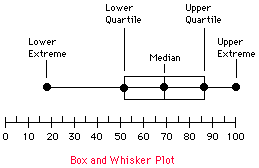| Subject: | Math A30 Concept B - Data Analysis |
| Topic: | Collecting Data off the Internet and creating Box and Whisker Plots |
| Objectives: | TSWBAT demonstrate developed skills
and understanding in collecting data for
a given situation. TSWBAT construct box and whisker plots from the collected data. |
| Materials Needed: | Internet access, web browser, calculator. |
| Teacher Notes: | This lesson covers objective B4 and to some degree, B1 from the A30 curriculum guide. |
Collecting Data on the Internet
Before you start to collect data on the Internet, it is assumed that the students are familiar with a variety of ways of collecting data and the advantages and disadvantages of using these methods.
Method 1: Using Search Engines
Once the students have decided on their topics, they can use a search engine to find any information contained on the Internet that is pertinent to their subject. Some of the more common search engines are "Lycos", "Infoseek", "Webcrawler", "Yahoo", and "Excite", just to name a few.
After the search is completed, the student can now start collecting data from a variety of web sites or it may only take a single site to collect the data. There are no handy tips that I can give you if your students choose this method. My only advice would be to enjoy the "surfing".
Method 2: The Canadian Resource Page
This is one of the best sites that I have come across for finding Canadian information on the Internet. This site is located at http://www.cs .cmu.edu/Unofficial/Canadiana/
The following is a list of some of the topics contained at this site that may be helpful for collecting data to use in your box and whisker plots:
Canadian Dollar exchange rates
Government Services (Revenue Canada & Statistics Canada)
The Weather Network
Ski Conditions
Lotto Results
Links to Canadian Based Publications
Facts & Figures section
Canadian Job Source
Financial Network
Links to Sports Leagues
Newsgroups (see below)
Many, many more!!!!
Method 3: Newsgroups
A newsgroup is similar to a bulletin board. A group of people with a common interest post messages on the website and whoever would like to read and reply to a particular message may do so. The message could also contain links to various websites that also relate to their particular topic.
In order to collect data from a newsgroup, first your students would have to find a newsgroup that relates to their topic. Teacher's Note: When you are doing a search for newsgroups, please be aware that there are many newsgroups that are not appropriate for children. Once they have found a newsgroup, they can post a message or question on the bulletin boad and hopefully they should have enough results within 24 to 48 hours that they can complete the box and whisker plots with "real-life" results. In order to get a more random sample, they may even want to post their question in a variety of newsgroups and then compare and constrast the different results and try and explain why the results came out the way they did.
Constructing Box and Whisker Plots
Some of the following information comes from an article titled, "Box-and-Whisker Plot Instructions" created by Jennifer Nord. It can be found on the Internet at, http://ellerbruch. nmu.edu/cs255/jnord/boxplot.html
The box and whisker plot is sometimes referred to as the five-number summary because a box and whisker plot displays five key numbers of any set of collected data. Those five numbers are the minimum value, the maximum value, the median, the lower quartile (the 25th percentile) and the upper quartile (the 75th percentile). If you are not familiar with percentile, if a number is at the 25th percentile that means that 25% of the data is below that number.
To construct a box and whisker plot, follow these steps:
| 1) | Arrange the data from least to greatest (this step will also give you your maximum and minimum values). |
| 2) | Find the median of the data. The median is the middle number when the numbers are arranged from least to greatest. If you have an even number of numbers then the median is the average of the middle two numbers. |
| 3) | Find the lower quartile. The lower quartile is found by finding the median of the numbers that are to the left of the median. |
| 4) | Find the upper quartile. The upper quartile is found by finding the median of the numbers that are to the right of the median. |
| 5) | Draw a number line that contains all of the values that is in the data. Place a dot above the numbers that represent your minimum value, the lower quartile, the median, the upper quartile, and your maximum value. |
| 6) | Draw a rectangle that has boundaries of the two quartiles. Then, draw a line through the rectangle at the median. (You have now made the box.) |
| 7) | Draw a line from the lower quartile to the minimum value and another line from the upper quartile to the maximum value. (The two lines are called the whiskers.) |
Fifteen boys were asked how many marbles they owned. The responses were as follows: 18 27 34 52 54 59 61 68 78 82 85 87 91 93 100.
| 1) | The median (middle number) of the data is 68. |
| 2) | The lower quartile is the median of 18 27 34 52 54 59 61. The lower quartile is 52. |
| 3) | The upper quartile is the median of 78 82 85 87 91 93 100. The upper quartile is 87. |
| 4) | Draw the graph. |
